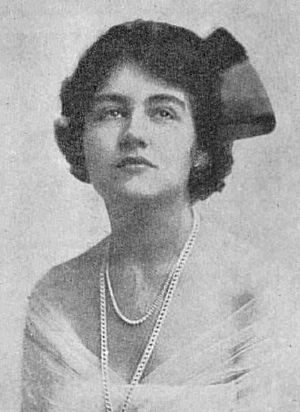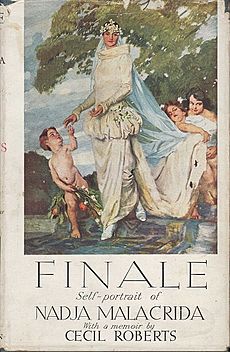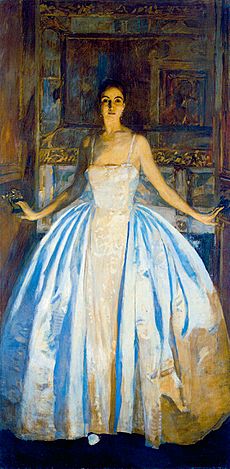Nadja Malacrida facts for kids
Quick facts for kids
Nadja Malacrida
|
|
|---|---|
| Marchesa Malacrida de Saint-August | |

Malacrida at the time of her marriage, 1922
|
|
| Born | Louisa Nadia Green 15 June 1895 Hampstead, London, England |
| Died | 3 October 1934 (aged 39) Henley-on-Thames, England |
| Buried | Fairmile Cemetery, Henley-on-Thames |
| Spouse(s) | Piero Malacrida de Saint-August |
| Occupation |
|
Nadja Malacrida, born Louisa Nadia Green (June 15, 1895 – October 3, 1934), was a talented English writer, radio host, and even a racing driver. She was also a well-known person in London's important social circles. She wrote novels, plays, and poems. During the First World War, she published three books of war poetry. After marrying an Italian nobleman, she became known as the Marchesa Malacrida de Saint-August.
Her Early Life
Nadja Malacrida was born in Hampstead, London, on June 15, 1895. She was the only child of Charles Edward Green, a businessman, and his wife, Louisa Cass. She grew up in Paddockhurst, a large country estate in West Sussex. This estate belonged to her aunt and uncle, Weetman Pearson, Lord Cowdray, and Annie Pearson, Lady Cowdray.
A Talented Writer
Nadja started writing at a young age. She published her first collection of poems, Evergreen, when she was just fourteen. A second edition of this book came out in 1912.
During the First World War, she published three more poetry books: Love and War (1915), For Empire and other poems (1916), and The full heart (1919). She gave all the money she earned from her war poetry to two charities. These charities helped soldiers who were blinded or disabled during the war.
Nadja also wrote books with her husband. They used the pen name P. N. Piermarini. These books, Life Begins To-Day (1923) and Footprints on the Sand (1924), were like stories based on real people and events in London society. In 1932, she wrote a play called Cheque Mate, using another pen name, Lewis Hope.
On the Radio and TV
Nadja Malacrida was also a pioneer in broadcasting. In 1933, she took part in an early television broadcast by John Logie Baird. This was a very new and exciting technology at the time.
In 1934, the last year of her life, she often read poems and stories on BBC radio. She used the name Nadja Green for her radio appearances. She also appeared in newspaper advertisements for Vim household cleaner. In these ads, she talked about how important it was to keep modern homes clean.
Her Personal Life
In June 1921, Nadja met her future husband, Marchese Piero Malacrida de Saint-August. He was an Italian journalist and a former cavalry officer. They met at a charity event at The Ritz Hotel, London.
They got married on December 6, 1922, at St Bartholomew-the-Great church. After their marriage, she became the Marchesa Malacrida de Saint-August. Her husband's family was a noble family from Italy.
Piero Malacrida also became involved in interior design. He designed beautiful interiors, especially luxury bathrooms, for wealthy people. The couple would buy apartments in fancy London areas, remodel them, and then sell them. They called their business "Olivotti."
The Malacridas were like celebrities of their time. They attended all the important social events in London. Newspapers often reported on their activities. Their marriage was said to be very happy. They wrote letters to each other every day when they were apart. Their letters from her last month were published in a book called Finale. Self-portrait of Nadja Malacrida.
A famous artist named Ettore Tito painted her portrait in 1926. Her husband later gave this painting to an art museum in Italy. Another portrait of her, painted by Olive Snell, was featured on the cover of The Sketch magazine in 1929.

A Sad Ending
On October 3, 1934, Nadja Malacrida died in a car accident. She was driving alone back to London from a friend's cottage near Henley-on-Thames. Her car went off the road while going uphill and fell down a 35-foot slope. She died immediately from her injuries. Her body was found outside the car, but her pet spaniel was found later, unharmed.
Nadja was a very experienced and skilled driver, having driven cars for 20 years. She and her husband both loved driving fast. They owned several luxury cars, including Hispano-Suiza, Mercedes, and Isotta Fraschini. She had even driven at the Brooklands motor racing track before. She is buried at Fairmile Cemetery in Henley-on-Thames.


